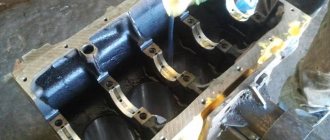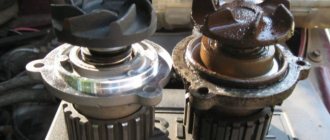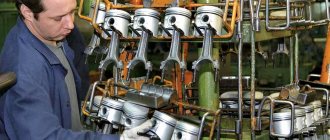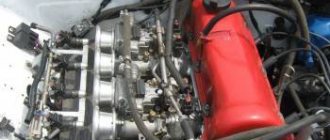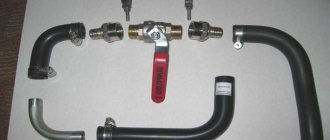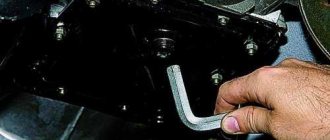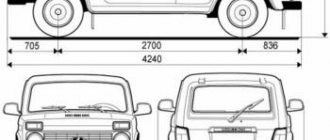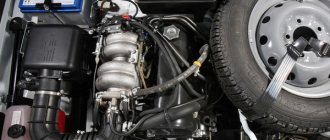Niva cylinder head gasket, specifics
What is the way out of this situation and what can be put into the engine? We have conducted quite a lot of experiments with the consent of regular customers. 5-7 gaskets from different manufacturers were tested on cars that are driven every day. In several cases, parts were sent to the trash bin during the visual inspection phase. Three manufacturers performed well. EZATI, Fritex, Ajusa (Spain). Subsequently, only the EZATI brand remained. In addition to the well-known metal package, Fritex also produces two series of shrink gaskets of very good quality. But unfortunately, it turned out to be very difficult to work directly with the plant in Yaroslavl and their dealers. And a representative of the Spanish brand, after noticing that this article was being actively purchased, raised prices so that the gasket began to cost more than the metal package.
cylinder head gasket 21213, 21214. Manufacturer EZATI
The cylinder head gasket of the EZATI Niva is also quite actively counterfeited, so we recommend buying it from a trusted place. It is very difficult to say how the original differs from a fake, but when you hold two spare parts in your hands, visually and tactilely, it is immediately clear. The surface of the original gasket, when touched, resembles “suede or nubuck” materials. Not shiny, not varnished, but rather slightly rough. In the area of the first cylinder there is an engraving of the catalog article. The structure of the crimp layers is similar to the effects of “shot peening”. All in small craters. Maybe this will be visible in the photo when enlarged. With proper installation, no penetration of this gasket was recorded. The service life is usually determined by the wear of the valve-guide pair. We also install this gasket in case of modified cylinder head. In the near future there are plans to make a small gift for the services, namely a set that will include a cylinder head gasket for an EZATI Niva, bolts, manifold and receiver gaskets, a exhaust pipe gasket and German copper-plated nuts. This is a kit that will include everything that needs to be changed in case of replacing the cylinder head.
Our specific problem
Now a few words about why the Niva cylinder head gasket breaks through and why this is a fairly widespread phenomenon. In a number of articles I have already mentioned that engine tuning can be intensive or extensive. Since 1967, the plant has been working exclusively on the second option, “stupidly” boring a block from a penny and not bothering with any other modifications. The oil pump, the pump cover, the cooling channels, the shape of the combustion chamber - everything remains from a “penny”. But modern environmental standards are pressing, and already in 2022 Euro-5 Nivas and Shnivys are leaving the plant, powered by an engine designed in the 60s of the last CENTURY)). And Euro-6 cars are made for export. Our “engineers” used several “tricks” that have been generally known since the time of King Pea. But the most interesting thing for us is increasing the operating temperature of the engine, bringing it close to the boiling point of our antifreeze. Namely 99-100 degrees, and the temperature at which the fans turn on is 105 degrees. Thus, we get the effect of “incandescent afterburning of the mixture.” There is a group of comrades who profess the saying: “there are no fools at the factory.” For them, let me remind you that in 1992, about 90 manufacturers of internal combustion engines gathered and adopted a standard for operating temperature, 90 degrees, with a permissible deviation of 3 degrees. Let's return to the field. Gaskets cannot withstand such operating temperatures. In the era of e-3, e-4, the plant begins to install Fritex metal packages on the conveyor and this is taught as a great technical breakthrough. But these gaskets begin to leak for another reason, a terribly roughly processed block plane. And in the e-5 era, the plant decides to “do some magic” with the firmware and go back to shrink gaskets. Well, the electronic gas pedal is just a “Klondike” for deceiving car owners. I don’t know from which manufacturer the spare part is now being installed on the assembly line, but at the services, a Niva or Chevrolet Niva cylinder head gasket, “punched” at 30-50 thousand, has not surprised anyone for a long time.
A little theory
The engine has three circuits: the working fluid (fuel, air, exhaust), oil and coolant. And the main task of the cylinder head gasket is to ensure that these circuits do not mix with each other. Today we can talk about three types of gaskets.
- Shrinkable or elastomeric. Initially they had a steel base on which an asbestos-graphite mixture was applied. It has modern versions, in a “non-asbestos” design and sealant applied around the channels. The oldest type of gaskets, from which factories are gradually moving away, and we are gradually returning.
- Multilayer steel, popularly called “metal package”. As a rule, in the middle of the gasket there is a layer of composite, and on top and bottom there are two thin crimping sheets of steel. The most striking example is Fritex pads, a Yaroslavl manufacturer. The factory also makes these gaskets for our engines, but I’ll tell you why it’s sometimes bad to install them a little later.
- Copper. The best type of gaskets today. Used on sports and special equipment. Of course, this is not copper in its pure form, but some alloys, but among the people they received this name. I saw similar gaskets for 21213 and 21214, but these were handmade products, that is, completely handmade.



